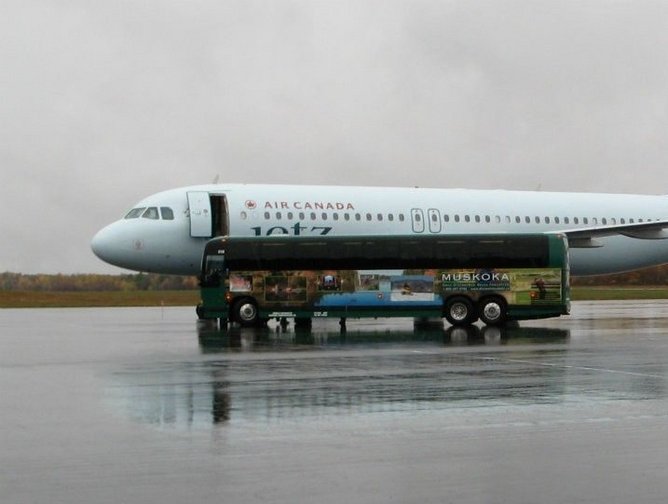By car, The District of Muskoka is a two-hour drive from Toronto. With its idyllic scenery of majestic forests and vibrant lakes, Muskoka has been a tourist destination for more than 100 years. In both 2011 and 2012, Muskoka was recognized by National Geographic Traveler as a top vacation destination. Just this year, it was named by MSN as one of the 10 greatest road trip destinations for the year.
While a road trip may be grand, the region boasts one of the best run airports in the country, which begs the question: Why drive when you can fly?
The Muskoka Airport plays a major role in the area’s bustling tourism business, providing an accessible international hub for a range of aircraft in the private and commercial sectors.
“Up to 71% of our visitors that come through the airport are from the USA,” District Chair John Klinck explained. “Although the airport does not support scheduled airline services, each year there are about 700 jet movements and over 2,000 turboprop aircraft movements that contribute to the commercial traffic activities at the airport. About 57% of the airport’s traffic is from commercially registered aircraft.”
The airport also acts a home for a dozen aviation businesses, employing around 75 people and helping to drive the local economy.
As industry trends shift, Muskoka Airport sees continued success for several different reasons.
A Focus on Commercial
The airport has remained successful thanks to a change in the types of aircraft that use the airport.
“Generally, light or private aircraft usage tends to be declining across the country, while in Muskoka we tend to have been experiencing an increase in commercial aircraft usage,” Klinck said. “Although our traffic from piston aircraft tends to decline slightly each year, we also tend to see that drop replaced by commercial jet, turboprop, and helicopter traffic. As such, our aviation gasoline (avgas) sales volumes suffer, while our jet fuel sales continue to improve.”
With increased commercial activity come increased revenues. In addition, the businesses which operate at the airport are taking advantage of this shift as well.
“Over the last decade, several businesses located at the airport have branched into servicing larger aircraft and commercial aircraft,” Klinck said. “These changes have opened up a host of opportunities for these businesses to expand, but also increase the burden on the airport to provide stronger taxiways and aprons, more reliable runway conditions in winter, and more space for their larger hangars. If we are to embrace the role of the airport to provide economic development for our municipality, then we need to adapt by providing the infrastructure, operating standards and development areas that these new businesses require.”
Expansion in All Areas
This kind of expansion is something the airport is already actively pursuing and it hopes to work with funding agencies and the private sector in the near future in order to move forward. Plans are already in place to refurbish the airport’s 6000 ft. runway in 2015. A longer-term 20-year plan is also being discussed.
“After identifying the anticipated improvements and their costs, the expenses are amortized over the 20 year period and a capital reserve contribution is made out of the airport’s operating budget each year to ensure we have the appropriate funds to properly support the airports upkeep and growth,” Klinck said. “Those contributions have grown over the last decade from about $80,000 per year to $500,000 per year. However, this financial commitment ensures that the Muskoka Airport is able to continuously improve its operation.”
As Klinck notes, however, they aren’t at all ignoring the piston aircraft traffic and are working to keep it steady.
“Muskoka Airport hopes to retain a significant share of the piston aircraft traffic by continuing to market the Muskoka area as a premier tourist destination, and to continue providing a preferred location for cross-country training flight stops from out-of-town flight schools,” Klinck said. “This airport attracts a lot more itinerant piston aircraft traffic than any of the other nearby airports, but an opportunity to expand our local flight training services could be very beneficial.”
A Culture of Cooperation
All told, the airport has only four full-time employees. The airport partners with Georgian College’s aviation management program to fill another spot. The full-time staff may seem small, but they’re highly trained in a variety of different fields, making each and every member invaluable.
“With such a wide variety of responsibilities at the airport, personnel need to possess a wide variety of skills and experience,” Klinck explains. “This variety makes the job interesting, but the main thing that attracts and retains employees is their love of aviation and the satisfaction that comes with contributing to a well-managed operation.”
The airport is also supported by District of Muskoka staff across all departments, from Public Works and Engineering to Finance and Legal. This is especially important since the airport must strike a balance between being a community service oriented organization, business, and industrial park. While this hasn’t always been easy, the airport is establishing a clear direction.
“We recently conducted reviews of many of our municipal services and are currently looking at creating an Airport Promotions and Partnership Committee,” Klinck said.
He also noted that with municipal elections soon taking place, the airport will soon be in a position to tackle various issues with a new District Council.
“Council and staff need to develop a new long term plan for the airport in 2015 in order to establish a clear and firm direction for the airport to follow that best serves the social and economic needs of the District of Muskoka,” he added.
The cooperation between the community and the airport is key, as the airport is extremely important to Muskoka. In the case of extreme forest fires, it acts as a response air base for the Ontario Ministry of Natural Resources. According to Klinck, these kinds of partnerships are the lifeblood of the airport and are good for the whole district.
“The Muskoka Airport is also very important to tourism in Muskoka and we hope to work with partners in the tourism industry to further promote the use of the Airport,” he said. “In particular, we have a unique opportunity to promote corporate meeting, conference and retreat type travel through our airport to our many resorts.”
Next time you’re planning a vacation, flying in to the Muskoka Airport and taking in the natural beauty around you might be a great option.





